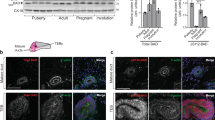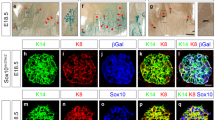Abstract
Two mammary gland phenotypes were detected in pregnant MMTV-cyclin D2 transgenic mice; line D2–53 exhibited a lack of alveologenesis and failure to nurse, whereas line D2–58 featured a reduction in alveologenesis, but retained normal nursing behavior. In pregnant mammary glands, cyclin D2 protein levels were twofold (P<0.107) and 3.8-fold (P<0.0076) higher in line D2–58 and D2–53, respectively, compared to wild type. Concomitantly with the increase in cyclin D2 was a fivefold decrease in cyclin D1 hyper-phosphorylated isoform in mammary glands of pregnant cyclin D2–58 mice. Because cyclin D1 is a critical molecule in normal mammary lobuloalveolar development, these data suggest that overexpression of cyclin D2 may block mammary lobuloalveolar development through inhibition of cyclin D1 phosphorylation. During mammary gland development, p27kip1 protein level oscillated in a similar profile in wild type and cyclin D2 transgenic mice, but was consistently higher in the cyclin D2 mice suggesting that p27kip1 functions downstream of cyclin D2. The ratio of p27kip1-cdk4/p27kip1-cdk2 was 6.5-fold (P<0.0003) higher in cyclin D2 mammary glands compared to wild type in pregnant animals. This ratio reversed to 2.2-fold (P<0.005) higher in wild type compared to cyclin D2 mammary glands in involution suggesting that overexpression of cyclin D2 moderately induced apoptosis during pregnancy but accelerated involution. Collectively, the effects of cyclin D2 overexpression on mammary gland development during pregnancy and involution are attributed to two major factors, altered p27kip1 protein level and inhibition of cyclin D1 phosphorylation.
This is a preview of subscription content, access via your institution
Access options
Subscribe to this journal
Receive 50 print issues and online access
$259.00 per year
only $5.18 per issue
Buy this article
- Purchase on Springer Link
- Instant access to full article PDF
Prices may be subject to local taxes which are calculated during checkout









Similar content being viewed by others
References
Barnes DM, Gillett CE . 1998 Breast Cancer Res. Treat. 52: 1–15
Bartkova J, Lukas J, Muller H, Lutzhoft D, Strauss M, Bartek J . 1994 Int. J. Cancer 57: 353–361
Bouchard C, Thieke K, Maier A, Saffrich R, Hanley-Hyde J, Ansorage W, Reed S, Sicinski P, Bartek J, Elers M . 1999 EMBO J 18: 5321–5333
Buckley MF, Sweeney KJE, Hamilton JA, Sini RL, Manning DL, Nicholson RI, deFazio A, Watts CKW, Musgrove EA, Sutherland RL . 1993 Oncogene 8: 2127–2133
Dickson C, Fantl V, Gillett C, Brookes S, Bartek J, Smith R, Fisher C, Barnes D, Peters G . 1995 Cancer Lett. 90: 43–50
Evron E, Umbricht CB, Korz D, Raman V, Loeb DM, Niranjan B, Buluwela L, Weitzman SA, Marks J, Sukumar S . 2001 Cancer Res. 61: 2782–2787
Fantl V, Edwards PAW, Steel JH, Vonderhaar BK, Dickson C . 1999 Dev. Biol. 212: 1–11
Fantl V, Stamp G, Andrew A, Rosewell I, Dickson C . 1995 Genes Dev. 9: 2364–2372
Han EK, Begemann M, Sgambato A, Soh JW, Doki Y, Xing WQ, Liu W, Weinstein IB . 1996 Cell Growth Differ. 7: 699–710
Han EK, Sgambato A, Jiang W, Zhang YJ, Santella RM, Doki Y, Cacace AM, Schieren I, Weinstein IB . 1995 Oncogene 10: 953–961
Harvey JM, Clark GM, Osborne CK, Allred DC . 1999 J. Clin. Oncol. 17: 1474–1481
Hartwell LH, Weinert TA . 1989 Science 246: 629–634
Houldsworth J, Reuter V, Bosl G, Chaganti R . 1997 Cell Growth Differ. 8: 292–299
Hunter T, Pines J . 1994 Cell 79: 573–582
Janz S, Jones GM, Muller JR, Potter M . 1995 Curr. Top Microbiol. Immunol. 194: 373–380
Jiang W, Kahn SM, Zhou P, Zhang YJ, Cacace AM, Infante AS, Doi S, Santella RM, Weinstein IB . 1993 Oncogene 8: 3447–3457
Lammie GA, Fantl V, Smith R, Schuuring E, Brookes S, Michalides R, Dickson C, Arnold A, Peters G . 1991 Oncogene 6: 439–444
Lukas J, Bartkova J, Welcker M, Petersen OW, Peters G, Strauss M, Bartek J . 1995 Oncogene 10: 2125–2134
Meyyappan M, Wong H, Hull C, Riabowol KT . 1998 Mol. Cell. Biol. 18: 3163–3172
Motpokura T, Bloom T, Goo-Kim H, Jüppner H, Ruderman JV, Kronenberg HM, Arnold A . 1991 Nature 350: 512–515
Murray AW . 1992 Nature 349: 603–608
Nivins JR . 1992 Science 258: 424–429
O'Connell MJ, Nurse P . 1994 Curr. Opin. Cell. Biol. 6: 867–871
Oyama T, Kashiwabara K, Yoshimoto K, Arnold A, Koerner F . 1998 Cancer Res. 58: 2876–2880
Pagano M, Theodoras AM, Tam SW, Draetta GF . 1994 Genes Dev. 8: 1627–1639
Pajic A, Spitkovsky D, Christoph B, Kempkes B, Schuhmacher M, Staege MS, Brielmeier M, Ellwart J, Kohlhuber F, Bornkamm GW, Polack A, Eick D . 2000 Int. J. Cancer 87: 787–793
Perez-Roger I, Kim S-H, Griffiths B, Sewing A, Land H . 1999 EMBO J 18: 5310–5320
Pestka S, Langer JA, Zoon KC, Samuel CE . 1987 Annu. Rev. Biochem. 56: 727–777
Rasmussen SB, Young LJT, Smith GH . 2000 Methods in mammary gland biology and breast cancer Ip MM and Asch BB (ed) New York: Kluwer Academic/Plenum Publishers, USA pp 75–85
Ravanko K, Jarvinen K, Paasinen-Sohns A, Holtta E . 2000 Cancer Res. 60: 5244–5253
Rosenberg CL, Kim HG, Shows TB, Kronenbergs HM, Arnold A . 1991 Oncogene 6: 449–453
Rosenberg CL, Wong E, Petty EM, Bale AE, Tsujimoto Y, Harris NL, Arnold A . 1991 Proc. Natl. Acad. Sci. USA 88: 9638–9642
Said TK, Luo L, Medina D . 1995 Carcinogenesis 16: 2507–2513
Said TK, Medina D . 1995 Carcinogenesis 16: 823–830
Said TK, Medina D . 1998 Mol. Carcinog. 22: 128–143
Scovassi AI, Stivala LA, Rossi L, Bianchi L, Prosperi E . 1997 Exp. Cell. Res. 237: 127–134
Sherr CJ . 1994 Cell 79: 551–555
Siciniski P, Donaher JL, Geng Y, Parker SB, Gardner H, Park MY, Robker RL, Richards J, McGinnis LK, Biggers JD, Eppig JJ, Bronson RT, Elledge SJ, Weinberg RA . 1996 Nature 384: 470–474
Siciniski P, Weinberg RA . 1997 J. Mammary Gland Biol. Neoplasia 2: 335–342
Sinn E, Muller W, Pattengale P, Tepler I, Wallace R, Leder P . 1987 Cell 49: 465–475
Weinberg RA . 1995 Cell 81: 323–330
Withers DA, Harvey RC, Faust JB, Melnyk O, Carey K, Meeker TC . 1991 Mol. Cell. Biol. 11: 4846–4853
Yosogawa Y, Takamo Y, Okayasu I, Kakita A . 1998 Pathol. Int. 48: 717–722
Yu Q, Geng Y, Sicinski P . 2001 Nature 411: 1017–1021
Acknowledgements
We acknowledge Dr Charles J Sherr at the Department of Tumor Cell Biology, St Jude Children's Research Hospital, Memphis, TN, USA for the cyclin D2 cDNA. This study was supported by NIH grant CA-11944.
Author information
Authors and Affiliations
Corresponding author
Rights and permissions
About this article
Cite this article
Kong, G., Chua, S., Yijun, Y. et al. Functional analysis of cyclin D2 and p27Kip1 in cyclin D2 transgenic mouse mammary gland during development. Oncogene 21, 7214–7225 (2002). https://doi.org/10.1038/sj.onc.1205895
Received:
Revised:
Accepted:
Published:
Issue Date:
DOI: https://doi.org/10.1038/sj.onc.1205895
Keywords
This article is cited by
-
Puberty-specific promotion of mammary tumorigenesis by a high animal fat diet
Breast Cancer Research (2015)
-
Pubertal high fat diet: effects on mammary cancer development
Breast Cancer Research (2013)
-
Genome-wide search identifies Ccnd2 as a direct transcriptional target of Elf5 in mouse mammary gland
BMC Molecular Biology (2010)
-
Alternative mammary oncogenic pathways are induced by D-type cyclins; MMTV-cyclin D3 transgenic mice develop squamous cell carcinoma
Oncogene (2003)



